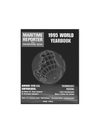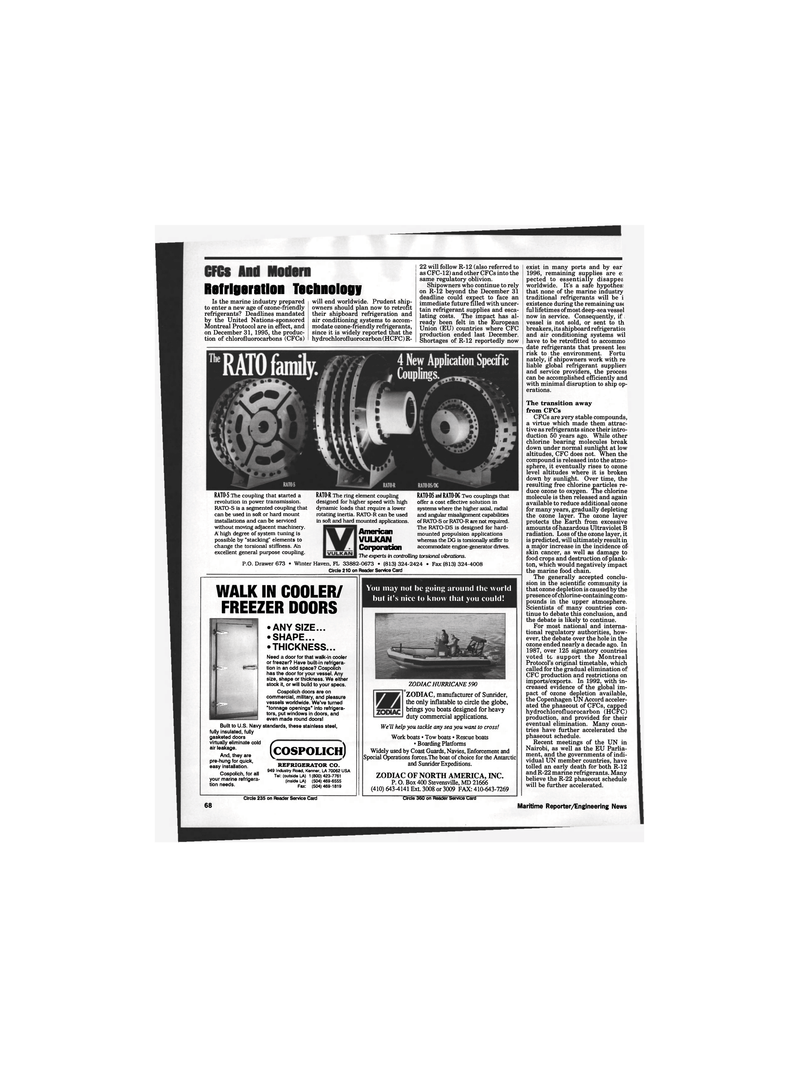
Page 66: of Maritime Reporter Magazine (June 1995)
Read this page in Pdf, Flash or Html5 edition of June 1995 Maritime Reporter Magazine
Refrigeration Technology
Is the marine industry prepared to enter a new age of ozone-friendly refrigerants? Deadlines mandated by the United Nations-sponsored
Montreal Protocol are in effect, and on December 31, 1995, the produc- tion of chlorofluorocarbons (CFCs) will end worldwide. Prudent ship- owners should plan now to retrofit their shipboard refrigeration and air conditioning systems to accom- modate ozone-friendly refrigerants, since it is widely reported that the hydrochlorofluorocarbon (HCFC) R- 22 will follow R-12 (also referred to as CFC-12) and other CFCs into the same regulatory oblivion.
Shipowners who continue to rely on R-12 beyond the December 31 deadline could expect to face an immediate future filled with uncer- tain refrigerant supplies and esca- lating costs. The impact has al- ready been felt in the European
Union (EU) countries where CFC production ended last December.
Shortages of R-12 reportedly now
RATO-S The coupling that started a revolution in power transmission.
RATO-S is a segmented coupling that can be used in soft or hard mount installations and can be serviced without moving adjacent machinery.
A high degree of system tuning is possible by "stacking" elements to change the torsional stiffness. An excellent general purpose coupling.
P.O. Drawer 673 • Winter
RATO-RThe ring element coupling designed for higher speed with high dynamic loads that require a lower rotating inertia. RATO-R can be used in soft and hard mounted applications.
American
VULKAN
RATO-DS and RATO-DG Two couplings that offer a cost effective solution in systems where the higher axial, radial and singular misalignment capabilities of RATO-S or RATO-R are not required.
The RATO-DS is designed for hard- mounted propulsion applications whereas the DG is torsionally stiffer to accommodate engine-generator drives. Corporation
The experts in controlling torsional vibrations.
Haven. FL 33882-0673 • (813) 324-2424 • Fax (813) 324-4008
Circle 210 on Reader Service Card
WALK IN COOLER/
FREEZER DOORS
Built to U.S. Navy fully insulated, fully gasketed doors virtually eliminate cold air leakage.
And, they are pre-hung for quick, easy installation.
Cospolich, for all your marine refrigera- tion needs. •ANY SIZE... •SHAPE... •THICKNESS...
Need a door for that walk-in cooler or freezer? Have built-in refrigera- tion in an odd space? Cospolich has the door for your vessel. Any size, shape or thickness. We either stock it, or will build to your specs.
Cospolich doors are on commercial, military, and pleasure vessels worldwide. We've turned "tonnage openings" into refrigera- tors, put windows in doors, and even made round doors! standards, these stainless steel, (COSPOLICH)
REFRIGERATOR CO. 949 Industry Road, Kenner, LA 70062 USA
Tel: (outside LA) 1 (800) 423-7761 (inside LA) (504) 469-6555
Fax: (504)469-1819
Circle 235 on Reader Service Card
You may not be going around the world but it's nice to know that you could!
ZODIAC HURRICANE 590
ZODIAC, manufacturer of Sunrider, the only inflatable to circle the globe, brings you boats designed for heavy duty commercial applications.
We'll help you tackle any sea you want to cross!
Work boats • Tow boats • Rescue boats • Boarding Platforms
Widely used by Coast Guards, Navies, Enforcement and
Special Operations forces.The boat of choice for the Antarctic and Sunrider Expeditions.
ZODIAC OF NORTH AMERICA, INC.
P. O. Box 400 Stevensville, MD 21666 (410) 643-4141 Ext. 3008 or 3009 FAX: 410-643-7269
Circle 360 on Reader Service Card exist in many ports and by ear 1996, remaining supplies are e: pected to essentially disappes worldwide. It's a safe hypothesi that none of the marine industry traditional refrigerants will be i existence during the remaining ust ful lifetimes of most deep-sea vessel now in service. Consequently, if ; vessel is not sold, or sent to th breakers, its shipboard refrigeratioi and air conditioning systems wil have to be retrofitted to accommo date refrigerants that present lest risk to the environment. Fortu nately, if shipowners work with re liable global refrigerant suppliers and service providers, the process can be accomplished efficiently and with minimal disruption to ship op- erations.
The transition away from CFCs
CFCs are yery stable compounds, a virtue which made them attrac- tive as refrigerants since their intro- duction 50 years ago. While other chlorine bearing molecules break down under normal sunlight at low altitudes, CFC does not. When the compound is released into the atmo- sphere, it eventually rises to ozone level altitudes where it is broken down by sunlight. Over time, the resulting free chlorine particles re- duce ozone to oxygen. The chlorine molecule is then released and again available to reduce additional ozone for many years, gradually depleting the ozone layer. The ozone layer protects the Earth from excessive amounts of hazardous Ultraviolet B radiation. Loss of the ozone layer, it is predicted, will ultimately result in a major increase in the incidence of skin cancer, as well as damage to food crops and destruction of plank- ton, which would negatively impact the marine food chain.
The generally accepted conclu- sion in the scientific community is that ozone depletion is caused by the presence of chlorine-containing com- pounds in the upper atmosphere.
Scientists of many countries con- tinue to debate this conclusion, and the debate is likely to continue.
For most national and interna- tional regulatory authorities, how- ever, the debate over the hole in the ozone ended nearly a decade ago. In 1987, over 125 signatory countries voted to support the Montreal
Protocol's original timetable, which called for the gradual elimination of
CFC production and restrictions on imports/exports. In 1992, with in- creased evidence of the global im- pact of ozone depletion available, the Copenhagen UN Accord acceler- ated the phaseout of CFCs, capped hydrochlorofluorocarbon (HCFC) production, and provided for their eventual elimination. Many coun- tries have further accelerated the phaseout schedule.
Recent meetings of the UN in
Nairobi, as well as the EU Parlia- ment, and the governments of indi- vidual UN member countries, have tolled an early death for both R-12 and R-22 marine refrigerants. Many believe the R-22 phaseout schedule will be further accelerated. 68 Maritime Reporter/Engineering News

 65
65

 67
67
